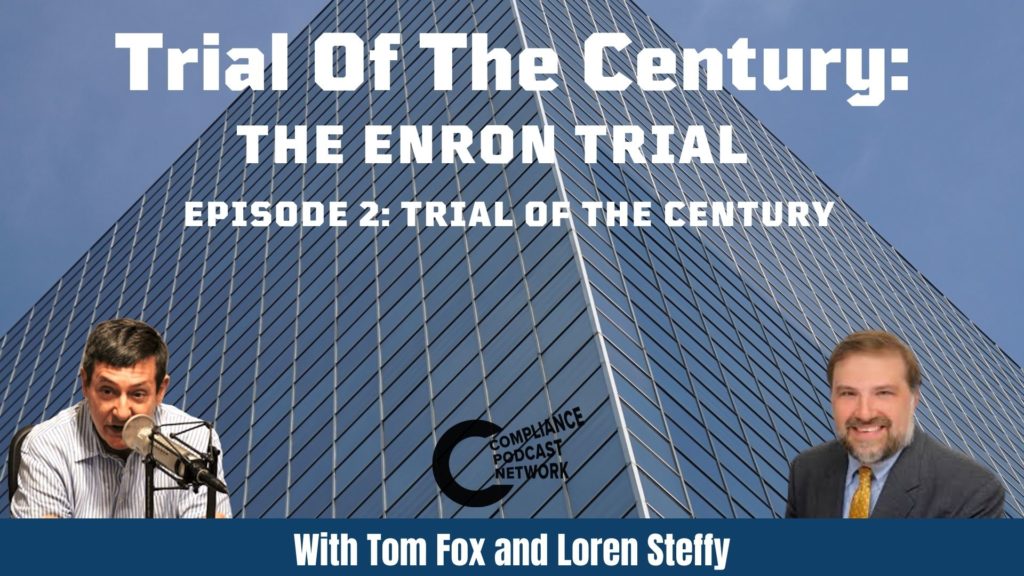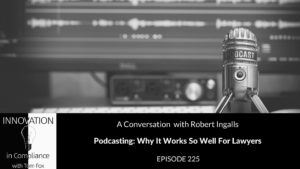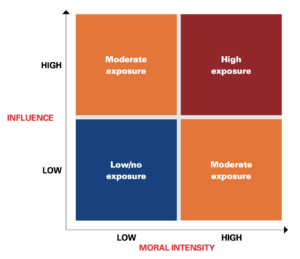The Compliance Life details the journey to and in the role of a Chief Compliance Officer. How does one come to sit in the CCO chair? What are some of the skills a CCO needs to success navigate the compliance waters in any company? What are some of the top challenges CCOs have faced and how did they meet them? These questions and many others will be explored in this new podcast series. Over four episodes each month on The Compliance Life, I visit with one current or former CCO to explore their journey to the CCO chair. This month, my guest is Valerie Charles, partner at StoneTurn. We discuss Valerie’s journey to the CCO chair, then to a ComTech start up, to her current role at StoneTurn and look down the road at where ComTech and compliance will be in 2025 and beyond.
In this concluding episode, Valerie looks down the road at the compliance function. She believes there will be increased use of ComTech by compliance functions. Moreover, CCOs and compliance professionals will need learn how to use data and become more comfortable in leveraging data for insights to help prevent, detect and remediate corporate conduct. The corporate compliance function will become even more important in the corporate setting as it will bring together various corporate functions such as legal, HR and IT into collaborative actions.
Resources
Valerie Charles LinkedIn Profile
Valerie Charles at StoneTurn
Day: January 25, 2022
OFAC FAQs on LIBOR
OFAC answers FAQs on sanctions and the discontinuation of LIBOR.

Loren Steffy and Tom Fox are back for another episode in The Enron Trial series. Here, Loren discusses the atmosphere in the courthouse, and what he observed over the course of the five-month-long trial.
The Trial Begins
“This was a criminal trial, but it was the trial of the century,” Loren believes; not only due to the company’s popularity, but because prosecution of executives was something that was not often seen. They are very difficult cases to prove, and Enron was no different.
The Prosecutor’s Strategy
The prosecutor avoided going into too much accounting detail, and instead kept the focus on the emotional aspect of the trial. “Enron was a great company to work for … People wanted to work there; they thought they were doing all these innovative things. Nobody wanted to lose their position in the company. They didn’t wanna lose their jobs, and they wound up getting caught up in this,” Loren tells Tom.
The Defence
The defence had a really tough time. Loren recounts one moment where Kenneth Lay was on the stand and openly questioned his attorney, “A couple of defence attorneys that were providing perspective said, ‘This is the turning point in the case.’ I mean, that was just so devastating that, you know, you just showed the jury that you don’t trust your own lawyer.” Jeffrey Skilling’s legal team employed an unusual tactic of commenting anonymously under Houston Chronicle blogs. In court, screenshots of these comments were actually utilised when the team made a motion to have the trial moved. “It was interesting,” Loren laughs about it.
The Closing Arguments
Again, it was less about accounting, and more about the deliberate attempt that was made to bamboozle their shareholders and employees – many people were hurt by it. “It wasn’t just a harmless lie,” said Loren, “there were real world consequences.”
RESOURCES
Loren Steffy | LinkedIn | Twitter
In this episode of Everything Compliance Shout Outs and Rants we have the following.
Karen Woody shouts out to the French TV show Call My Agent, reminding us that by watching a French language show with subtitles you can see really funny TV and learn French.
Jay Rosen rants about Boston sportswriter Longtime Boston Globe columnist Dan Shaughnessy for not voting for Red Sox great David Ortiz for the Baseball Hall of Fame.
Tom Fox shouts out the Joel Coen movie Macbeth and starts Oscar buzz for Kathryn Hunter as Best Supporting Actress.
Matt Kelly laments about the story of Harmony Montgomery, now missing for over 2 years because no one would take her mother’s speaking up about her disappearance seriously.
Jonathan Armstrong shouts out to UK artist Tracy Emin who shames British PM BoJo by asking for removal of her art from No. 10. He ends with the plea BoJo Must Go!

Robert Ingalls is Tom Fox’s guest on this episode of the Innovation in Compliance Podcast. He is the Chief Product Strategist at Law Pods, a podcast for busy attorneys. In this episode, Robert and Tom talk about the power of podcasting as a medium for professionals in legal fields, why it works, and what’s in store for the future of podcasting in the legal industry.
What Makes Podcasting Work
Consumer behavior is shifting, and so are people’s learning styles. Nowadays people want to be entertained whilst receiving information; podcasts are a great medium for this, especially for legal professionals who wish to pass on legal expertise to a wider audience. “When you make a podcast you’re asking them to press play and keep living their life,” Robert tells Tom. Audio allows people to consume content in a way that is most convenient and accessible to them.
Making The Leap
Lawyers have had the ability to produce audio content for many years. Tom asks Robert why this was never utilized until recently. “Because they don’t need the new thing,” Robert replies, cheekily. A lot of law firms catch up with the trends slowly, and they also hope that the new trends will fizzle out or go away so they don’t have to implement them. However, the legal industry is shifting and lawyers and other legal professionals are making the leap into audio content, and picking up on social media a lot faster than they used to. They are noticing that other law firms are doing so as well, and that their clients are reacting to it. Law firms are now understanding that consumer culture is shifting and taking necessary measures to stay relevant.
The Power of Storytelling
The easiest way to attract someone to your content is via interesting and authentic stories that are also a little informal. “Be a little more informal… relax yourself and tell [your listeners] what you would want to tell them in that kind of [cocktail party] environment and pepper in some stories,” Robert advises Tom and the listening audience. The podcast is a unique area to use your voice to make a connection with someone else. When storytelling attracts your audience, it encourages them to come back, which in turn motivates them to share your content.
What’s Next
In the near future, there will be a period of concentrated growth. People will be able to ask legal questions via their digital assistants and get specific answers from lawyers, that are segmented audio clips from podcasts. Podcasting will no longer be considered something that is a fad to the legal industry but a useful tool.
Resources
Robert Ingalls | LinkedIn | Twitter
Law Pods
The compliance intersection with Environmental, Social, and Corporate Governance (ESG) continues to drive many initiatives in both the ESG realm as well as compliance. One of the key areas is in found in corporate Supply Chain, particularly around human rights, human trafficking and modern slavery. The Uyghur Forced Labor Prevention Act puts additional pressure on companies who do business with China to be able to affirmatively show no goods or services were produced through forced labor involving the Chinese Uyghur population, much to the consternation of the Chinese government. Most compliance professionals depend on language in supplier contracts which certify that no products are the result of slave labor. A New York Times (NYT) piece, entitled U.S. Effort to Combat Forced Labor Targets Corporate China Ties, reported, “One of the biggest hurdles for U.S. businesses is determining whether their products touched Xinjiang at any point in the supply chain. Many companies complain that beyond their direct suppliers, they lack the leverage to demand information from the Chinese firms that manufacture raw materials and parts.” However, that most basic approach is no longer adequate.
In a recent Sloan Management Review article, entitled “Does Your Business Need a Human Rights Strategy?,” authors N. Craig Smith, Markus Scholz and Jane Williams took a solid look at both the risk side of this equation as well developing a corporate strategy to deal with the issue. Over the next couple of blog posts, I will be exploring the article in the context of the compliance professional and a corporate ESG strategy.
While the Chinese response may be painful, it will frankly pale next to the response from the US government and the buying public. With so much increased attention to human rights, the authors believe “businesses that turn a blind eye to violations that occur in their sphere of operations face the risk of being exposed as morally complicit as well as vulnerable to legal action and reputational harm. That’s why it’s critical for companies to have a human rights strategy and proactively consider when and how to take the action needed to fulfill their moral obligations; meet shareholder, customer, and employee expectations; and keep other stakeholders satisfied.”
Three Categories of Human Rights Violations
The authors believe there are three broad categories of human rights issues. They are:
- Abuse in the way a company’s products or services are made or delivered. This includes abuse by suppliers or contractors or within a company’s own operations. Although most western companies believe this is not a problem for them, a UK investigation found a slave labor operation within the country itself, which was supplying food products to such UK retailors as Tesco, Sainsbury’s and others.
- Abuse in the way a company’s products or services are used. This includes companies that find themselves complicit when customers employ their products or services to do so — if not legally complicit, then at least guilty in the court of public opinion. The obvious example here are the digital surveillance systems sold to Chinese security agencies and used to implement a mass surveillance program against minority groups while creating an overall surveillance state within the country.
- Abuse by regimes where the company operates. This may be one of the trickiest to navigate. Obviously working with governments is an important business component but even working with the US government can be trick as McKinsey found out when it contracted with Customs and Borders and “Media reports suggested that the consultancy had been redirected to assist in former President Donald Trump’s clampdown on illegal immigration and was responsible for money-saving recommendations that included cuts in funding for food, medical care, and the supervision of detainees.”
Obligations to Address Human Rights
Both compliance and ESG have driven the discussion on the role of the corporation in dealing with this issue. The Business Roundtable’s Statement on the Purpose of a Corporation also pointed in this direction. Companies are now being called to engage as responsible corporate citizens in a wide variety of areas, including human rights. The authors see four reasons why a company should consider human rights a priority. (1) Moral reasons. The fight against human trafficking and slavery are moral duties that require not simply a call for action but real action. Inaction is no longer acceptable. (2) Legal considerations. Together with the US, multiple countries have enacted laws that require organizations to act in ways that protect and promote human rights. (3) Soft laws. Standards may come into play, such as the United Nations’ Guiding Principles on Business and Human Rights, and are becoming more important. (4) Reputation. With social media, amplifying human trafficking and other human rights issues which may have been more inconspicuous in the past, it is making businesses increasingly vulnerable to being accused of complicity.
Corporate Exposure

The authors have developed an approach which identifies key factors driving ““corporate human rights strategies and used them to create an exposure” scale. This tool captures both the moral intensity and the potential influence of a company in a specific situation.” Understanding where your organization lies on such a scale can assist a Chief Compliance Officer (CCO) or compliance professional to not only lead a discussion but more importantly help to formulate a corporate response. The twin axis are moral intensity and influence. Moral intensity “captures the degree to which people see a situation as unethical and demanding of action.” Some of the questions you need to consider include what is the magnitude of consequences? The extent of the harm likely to result? What is the social consensus, the extent to which people agree on the moral rights and wrongs of an issue? What is the probability of effect and how likely is harm to happen? What is the “Temporal immediacy. How urgent is the issue? Is fast action required to prevent harm?” How near is your organization to the issue and what part of your stakeholder communities will be affected by the issue?
The authors believe that determining influence is even trickier. They believe a nuanced approach should be used when assessing an organization’s influence. Their approach includes reviewing institutional factors, then understand “What are the formal and informal rules and values that shape the environment, including willingness — or pressure — to conform?” Next look at some industry specifics to help understand “How is influence affected by factors such as the complexity of supply chains, the geographic location of where vital products are sourced, or the degree of concentration or fragmentation of the industry?” From there review your resources to help understand “What can the organization bring to bear to influence the issue?” Such a review would look at both “tangible resources, such as funds, inventory, land, and buildings;” as well as “intangible ones, such as networks, skills, and knowledge.” Finally, consider embeddedness, which is “How closely and on how many levels is the company entangled with the perpetrators of abuse?”
Tomorrow we will look at how you can create a corporate human rights strategy for your corporate compliance regime or ESG program based upon the authors’ model.


